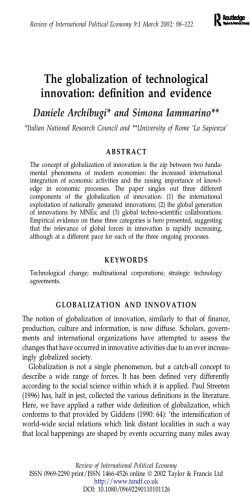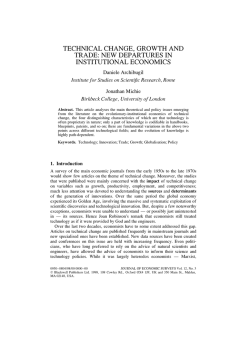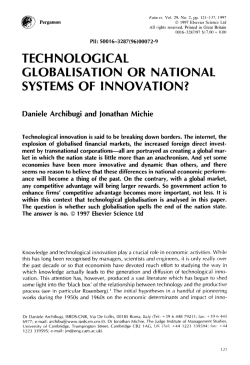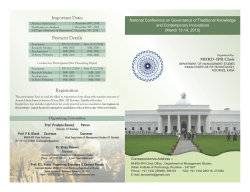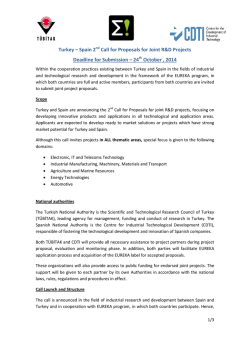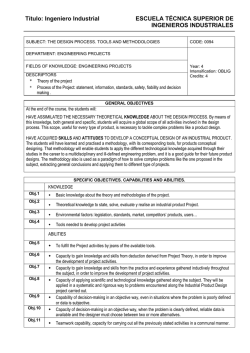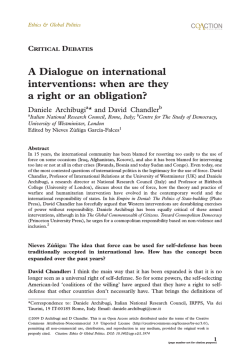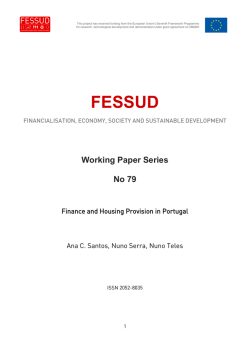
Download - Daniele Archibugi
International Journal of the Economics of Business, Vol. 5, No. 3, 1998, pp. 295± 309 Objects and Subjects in Technological Interdependence. Towards a Framework to Monitor Innovation DANIELE ARCHIBUGI and ROBERTO SIMONETTI ABSTRACT Technology, even more than other aspects of economic life, is characterized by a strong interdependence across both sectors and organizations. However, we still know little about the determinants and impact of technological interdependence. The standard input± output analysis is unable to explain interdependence in technological life since a large proportion of innovations are either untraded or are disembodied from products. Innovations which are not appropriated by the innovators are not signalled by prices. Moreover, input± output tables do not systematically consider exchanges within economic organizations, such as ® rms. This paper proposes a more complex accounting framework for innovation which would monitor the technological ® eld of the innovation and the product where it is used, as well as the producer± user interrelationship. Key words: Innovation; Technical change; R&D. JEL classi® cations: O3, O31 1. The Importance of Technological Interdependence It is no exaggeration to say that economics as a science was born to study the issue of interdependence among sectors. The ® rst and still astonishing analytical tool to account for the effect of such interdependence in economic life was Quesnay’s Tableau eÂconomique. Since then, economists have undertaken a long and successful journey to develop techniques and devices to analyse and measure interdependence. The majority of these methods have been devoted to studying interdependence in products and services. Interdependence in technological knowledge, however, has received systematic attention only over the past decade (Ergas, 1983; Nelson, 1986; Kodama, 1986; van Raan, 1988; Leontief, 1989; DeBresson, 1996). This paper presents some philosophical speculations on the nature of technoDaniele Archibugi, National Research Council, Via Cesare De Lollis 12± 00185 Rome, Italy. Tel: 1 39 6 44879 211; Fax: 1 39 6 4463836; e-mail: [email protected]. Roberto Simonetti, Faculty of Social Sciences, Open University, Walton Hall, Milton Keynes, Bucks MK7 6AA, UK. Tel: 1 44 1908 654552; Fax: 1 44 1908 654488; e-mail k [email protected] l 1357-1516/98/030295-15 $7.00 Ó 1998 Carfax Publishing Ltd 296 D. Archibugi and R. Simonetti logical interdependence, a topic that is becoming increasingly investigated. Most economists would agree with the premise that technology (a shorthand that encompasses various types of human activities often referred to as `knowhow’ , `knowledge’, `invention’ or `innovation’) is a fundamental element in advanced societies since it plays a crucial role in explaining measurable economic variables such as productivity, growth, employment and competitiveness. Moreover, technology is also increasing considerably in importance as post-industrial societies are becoming more knowledge-intensive. It is no surprise, therefore, that economists are increasingly researching the sources and effects of new technology. Many studies in the economics of innovation have pointed out that technology is best understood from a system perspective (De Liso and Metcalfe, 1996; Landes, 1969; Rosenberg, 1976, 1982). Even apparently simple products embody very different types of knowledge which are not always available to a single organization and are not always embodied in goods that can be purchased on the market. Many ® rms access valuable knowledge both through market exchange (e.g. through the purchase of capital or intermediate goods or licensing agreements), and through less formal contacts with suppliers, customers, universities, government agencies and other organizations. It is a well-known fact that ® rms with little innovative activity may enjoy a satisfactory economic performance because of the capabilities they acquire from upstream suppliers. The same applies at the sectoral level: some fast-growing industries, for example in the service sector, do not themselves produce technological innovations to any signi® cant degree (Scherer, 1982c; Griliches and Lichtenberg, 1984). The economic environment in which ® rms operate is therefore crucial for the development of their technological capabilities. This fact is increasingly acknowledged, and the terms ª national systems of innovationº (Lundvall, 1992; Nelson, 1992; Archibugi, Howells and Michie, 1999) and ª technology systemsº (Carlsson and Jacobsson, 1996; Simonetti, 1998) have been introduced in order to analyse the complex webs of interactions between institutions and industries in the innovation process. Interdependence, thus, plays a key role in the generation and use of technology. However, its conceptualization and measurement are still at a rudimentary stage, due no doubt to the rather elusive nature of technology (Arrow, 1962; Hansen, 1986; OECD, 1987; Archibugi, 1988a). Indeed, the literature on the economics of innovation has highlighted a number of issues that relate to the nature of technology and are connected to the nature of interdependence. The purpose of this article is to explore technological interdependence and to suggest a method to address it. The next section will outline some characteristics of technology, while Section 3 will introduce a framework that deals with the measurement of technological interdependence. Sections 4, 5 and 6 will discuss some empirical issues that arise in the measurement of technological ¯ ows between sectors. Some prospects for future research will conclude this paper. 2. Technological Knowledge and Interdependence The key characteristics of the technological knowledge which are relevant for the analysis of technological interdependence can be synthesised in the following points. Technological Interdependence 297 (i) Public vs. Private The term technology is used to refer to both a tangible artefact and to the knowledge necessary to produce it (Metcalfe, 1995). While the former can be sold only once, the latter is a very valuable resource as the holders can use it inde® nitely and even give it to others without reducing it (it is a `non-rivalrous’ good). A distinction is generally made between knowledge that is codi® able (that is, fairly easy to articulate and therefore to transfer, like blueprints or information) and knowledge that is tacit, non-codi® able (PolaÁnyi, 1967). Codi® able knowledge is a `public good’ because it is `non-excludable’, that is, the holder cannot prevent others from using it. Tacit knowledge, which is usually acquired through experience, cannot be articulated and it is therefore more dif® cult to transfer: it is embodied in individuals and organizations. Usually technology is neither purely public (codi® able) nor purely private (tacit), but a mixture of the two, which varies across sectors and with time. (ii) Embodiment Since technology exists in both an embodied form, as physical products, and in a disembodied form, as ideas or skills, the transfer of technology can occur in the form of new artefacts or of new ideas. Between these two extreme cases, however, there are various intermediate cases. (iii) Heterogeneity Of all the economic entities, technology is the most multifarious and least homogeneous. Innovations display very wide differences in terms of their economic and social signi® cance and it is very dif® cult to reduce them to a common yardstick. The discontinuous nature of innovative activity is also re¯ ected in the measures used to account for it: although students in the ® eld have been ingenious in developing devices to provide operational measures, these are not yet as accurate as those available for the majority of economic variables. (iv) Uncertainty and Appropriability The bene® ts derived from investment in technology are not easily predictable for two reasons. First, investment in research and related activities involves a large degree of uncertainty; you can search but you do not know whether you will ® nd anything or what will be its economic value. Second, because of the public nature of technology there are no general rules to predict what share of the bene® ts of any innovation will be earned by the innovator since several users may bene® t from it without charge (von Hippel, 1988). Despite the existence of institutions designed to protect intellectual property rights, remarkable differences in these shares can be found across single innovations, technological ® elds, industrial sectors, and countries (Levin et al., 1987). (v) Intentionality Compared to the exchange of physical products and services, the transfer of technology can take a larger variety of forms. Because of the partly public nature 298 D. Archibugi and R. Simonetti of technology, there may be cases where a certain know-how spills over from the producers against their will. Technology may leak out from the producers to the users since it can be acquired through a variety of channels, such as imitation and reverse engineering. A crucial difference can therefore be drawn between the transfer of technology on the one hand and the transfer of goods and services on the other, namely the lack of intentionality in the former: a large portion of technology transfer does not take place in market transactions (see von Hippel, 1982, 1987; Carter, 1989; TorreÂ, 1992). Because of the partly tacit nature of technological knowledge, the mismatch between intentionality and transfer also works in the opposite direction: there are cases where producers do not manage to transfer their expertise to others in spite of their intentions (multinational ® rms are familiar with this problem when they try to transfer know-how to their subsidiaries, especially when these are located in developing countries). (vi) Variability The production of knowledge is not uniform across the economic space. First, just a few institutions (® rms, research centres, universities, and so on), often concentrated in selected industries, tend to provide the majority of innovations for the whole economic system. Second, as Schumpeter and his followers have extensively pointed out, a cluster of innovations can play a prominent role in certain periods driving the economic growth of the entire economy (Schumpeter, 1934, 1939, 1942; Freeman, Clark and Soete, 1982; Freeman and Soete, 1990; De Bresson, 1996). 3. A Framework for the Measurement of Technological Interdependence Given the elusive nature of technology and the variety of forms in which technology ¯ ows between institutions and sectors, how is it possible to ® nd a method able to measure and perhaps predict the nature of technological interdependence? First, the heterogeneous nature of technology is a major statistical problem. This is essentially a problem of measurement. But, as is often the case with measurement, it involves substantial analytical and methodological issues. Enormous effort has been devoted to developing new measures of innovative activities and sources as diverse as the resources devoted to R&D (OECD, 1981; Freeman, 1992), patenting (Basberg, 1987; Pavitt, 1988; Griliches, 1990; Archibugi, 1992), and collections of data on the introduction of signi® cant innovations (Townsend et al., 1981; DeBresson, 1986; Acs and Audretsch, 1989; Smith, 1990) have been employed. But before we discuss the nature of the currently available measures, it is crucial to identify the information which should be extracted from each observation relevant to the analysis of interdependence. Developing and extending the framework of the pioneering research of Jacob Schmookler (1966, 1971), the Science Policy Research Unit (SPRU) innovation database (Townsend et al., 1981) and Mike Scherer (1982a), each innovation monitored should be classi® ed according to, at least, ® ve different criteria: (1) The technological nature of the innovation. This implies a technical description of the innovation. At a subsequent stage, homogeneous innovations based on technical and engineering characteristics are grouped in technological cate- Technological Interdependence Objects Innovations Subjects Human needs 299 1) Technology 3) Products 2) Producing firms 4) Using firms 5) Human needs Figure 1. Criteria to monitor and classify innovations. (2) (3) (4) (5) gories. In other words, innovations in such technologies as chemicals, electronics, pharmaceuticals and so on are grouped together. This classi® cation is concerned with the objects of technological change. The prevalent economic activity of the organization producing the innovation, which we shall call the sector of activity of the producing organization (or sector of production). In the case of ® rms, the activity of the producing organization is equivalent to the branch of its main economic activity. This second criterion demands the presence of a subject to promote the innovation, be it a ® rm, a government body, or a commercial organization. While criterion (1) monitors the innovation’s technological group, and hence its object, criterion (2) monitors that of its economic subject. The product group where the innovation is used, understood as the product of the ® rst application of the innovation. Here too, as in point (1) the economic object of innovation is considered. However, while point (1) classi® es its technological content, this criterion classi® es the product of its destination. The using organization, understood, as in point (3), as the organization which ® rst applies the innovation. Here too, as in point (2), the economic subjects of innovation are considered. However, while point (2) is concerned with the producers of innovations, this criterion focuses on the users. The human needs which the innovation is designed to address. Although this often shapes the forms of interdependence, it is outside the scope of this paper. When we monitor an innovation, we therefore have to answer ® ve questions: (1) What kind of innovation? (2) Made by whom? (3) Used in which product? (4) Used by whom? (5) For which human bene® ts? Figure 1 highlights the ® ve criteria. 4. The Problem of Sectoral Aggregation The ® rst four criteria listed above can be recorded for individual innovations. However, to make sense of this information and to process it with quantitative methods, the innovations also need to be grouped into sectors. Criterion (3) is explicitly related to a sectoral classi® cation; a commodity is such only if there is a variety of similar goods which can be grouped into a category.1 Criterion (1) refers to innovations which have not necessarily to be grouped in sectors; historians of technology, for example, are happy to deal with them chronologically (Gille, 1978). However, in order to make sense of this information for economic analysis, they need to be grouped into sectors of a certain homogeneity. 300 D. Archibugi and R. Simonetti Criterion (2) is collected for individual organizations and it may be grouped into sectors according to the principal economic activity of the individual ® rms. Criterion (4) is the most dif® cult to collect since the producer of an innovation does not necessarily know the names of the organizations which are using it. It is more likely to predict the product in which the innovations will be used than the name or even the principal economic activity of the organizations which will use it. The choice of the classi® cation to be used can be solved in two different ways: (i) use the same classi® cation to de® ne all the criteria listed. This allows one to work on symmetric axes, which in turn allows one to use a wider number of statistical techniques; (ii) adopt different classi® cations for each criteria, which provides a more accurate picture of each aspect considered but also puts severe constraints on the statistical techniques applicable. Since criterion (1) is typically technological, it does not necessarily correspond to economic classi® cations; the most detailed available classi® cations for innovations according to this criterion are those used by patent of® ces.2 There are a variety of classi® cations designed for products which can be employed for criterion (3), most notably those used for international trade ¯ ows. Criteria (2) and (4), in turn, require the use of the same classi® cation since both of them deal with economic organizations, i.e. ® rms. In the majority of cases, ® rms are grouped according to their principal economic (i.e. product) group. In order to assess the relative importance of small and large ® rms in the production of innovations, others have classi® ed ® rms according to their size. Other attempts have however been made to classify ® rms according to their sources of innovation (see, for example, Pavitt, 1984; Cesaratto and Mangano, 1992). Let us assume that, thanks to the employment of accurate concordance tables, the same classi® cation is used for all the four criteria (the SPRU innovation database, for example, has used the Standard Industrial Codes to classify innovations according to the criteria (1), (2) and (3)). The four types of classi® cation may coincide for some innovations, e.g. a chemical process produced by a chemical ® rm and used for the production of a chemical product by the same ® rm or others in the chemical industry. In other cases, they may differ, e.g. a coffee machine (according to the ® rst criterion, the technological group is that of `machinery’) produced by an automobile ® rm (according to the second, the production sector is that of `means of transport’), used to make the product `coffee’ (according to the third, the product of use is `beverages’) and used in the restaurants (according to the fourth, the utilization sector is that of `catering’). It is not always easy to classify each individual innovation on the basis of all four criteria, and conceptual and monitoring problems arise. Criterion (1) is dif® cult to apply at high levels of disaggregation. It is, for example, hard to distinguish on purely technological grounds certain chemical products and processes from pharmaceutical products and processes. If we restricted ourselves to the analysis of chemical formulae, we would often ® nd great similarities between the technological characteristics of chemical and pharmaceutical products and processes. A satisfactory classi® cation from the technological viewpoint must therefore also bear in mind criterion (2), i.e. the type of organizations promoting the innovation, such as clinical laboratories or chemical companies, criterion (3), i.e. in which products the innovation is to be used, such as drugs or fertilizers, and Technological Interdependence 301 criterion (4), i.e. the sectors the innovation is utilized in, such as hospitals or agricultural companies, etc. It is more likely that chemicals and pharmaceuticals may be differentiated only taking into account criterion (5), i.e. the human need they satisfy. Problems of a different nature arise in grouping producing and using sectors of innovation. First, technological change in industrialized countries is produced both by ® rms and by government bodies and universities. All too often, the economics of innovation considers only the business sector, and more speci® cally manufacturing. It is, in fact, dif® cult to ® nd classi® cations at the same level for manufacturing ® rms, the service sector and government bodies. Consequently the role played in the inventive and innovative process by government research bodies, universities and service companies is often overlooked. As regards ® rms, it is necessary to decide whether to monitor innovations at the level of individual productive units (establishments) or at the level of industrial groups (corporations) or both. This problem becomes particularly relevant when considering branches of multinational companies with divisions in several countries. According to the decision taken, the results can differ considerably. Finally, we should consider more than a single product of utilization according to the third criterion and the single sector of utilization according to the fourth criterion. Economic analysis is concerned not only with the ® rst product and sector to use innovations, but also with the diffusion of the innovation into other products and sectors over time. One of the characteristics of technological innovation is precisely that of penetrating several products and sectors. Even when the ® rst product and sector of utilization is identi® ed, there is no certainty that this is the main utilization product and sector. This analytic framework, therefore, gives more weight to the generation than to the diffusion of innovations. However, it is possible to enlarge this accounting framework to include also the diffusion of innovations across industries, ® rms and products. To deal with the heterogeneous nature of innovations, a variety of studies have proposed classifying innovations as ª improvementsº and ª basicº (Mensch, 1979), or as ª incrementalº and ª discreteº (Priest and Hill, 1980), and Freeman has presented a detailed taxonomy of innovations ranked according to their impact on economic and social life (Freeman, 1992). Several scholars have assessed the value of individual innovations, often referring to textbooks of technology history as primary sources. Subjective choices are inevitably made in judging the relative importance of each innovation. Although these approaches have commonly highlighted the great differences in the economic impact of individual innovations, they are less concerned with the direct measurement of interdependence. The framework presented above allows one to give a speci® c weight to individual innovations in a less subjective way and therefore to transform heterogeneous observations into comparable variables. Individual innovations may be weighted according to the number of ® rms or products which use it. Since the rate of growth of a sector is often associated with its capability to absorb technology, the number of innovations used by sectors can also be a crucial piece of information for predicting its rate of growth. An individual assessment of innovations may also allow one to rate them according to their degree of `appropriability’ : if they are entirely appropriable by the producer, the technology transfer will be re¯ ected in explicit economic transactions (in the form of either a market for a product which embodies the 302 D. Archibugi and R. Simonetti Technological groups j vector a Product groups i vector a© INN ij Figure 2. Objects Matrix. Innovations by technological ® eld and product of use. innovation or a license fee to use it). If at the other extreme the innovation is freely available, there is no price signal which can be used to gather the technology transfer, which in turn can be detected only by looking directly at the sectors of use of the innovation. 5. Subjects and Objects in Technological Interdependence The framework described above is designed to deal with the problem of interdependence across sectors. Such interdependence, however, can be approached from two different perspectives: the ® rst regards the objects, the second the subjects of technological change. The ® rst is the equivalent of the input± output matrix, the second takes into account interrelations between agents (® rms, research centres, etc.) and it therefore provides information on the issues addressed by scholars in the ® eld of industrial organization. Matching criteria (1) and (3) it is possible to obtain a matrix which is equivalent to the economic input± output table; we will call it the Objects Matrix (see Figure 2). Empirical applications of it have been obtained using indicators as diverse as R&D, patenting and innovation surveys by Scherer (1982a, 1982b, 1982c); SeÂguin Dulude (1982); Robson, Townsend and Pavitt (1988); Soete (1986); Marengo and Sterlacchini (1990); Simonetti (1989). An alternative approach is to consider a square matrix matching criteria (2) and (4), which we will call the Subjects Matrix (see Figure 3): in this latter case, we are no longer dealing with technical relations but with economic relations between ® rms (DeBresson and Townsend, 1978; DeBresson et al., 1992; data collected by the Financial Times reported in Soete, 1986). The Objects Matrix indicates the extent to which certain technological ® elds penetrate economic life. The empirical analyses carried out show, for example, that machinery technology is relevant for the majority of products. In a dynamic perspective, they also show that electronics is substantially increasing its relevance 303 Sector of activity of the using organization k vector c© vector c Sector of activity of the producing organization y Technological Interdependence INN yk y Figure 3. Subjects Matrix. Innovations by sector of production and of use of the organization. in downstream sectors. The information provided by the Objects Matrix is of relevance for policy making since it indicates which technological ® elds should be promoted to obtain gains in the economic performance of each product group. It may also help to predict the sort of economic transformations which will be generated by technical advances in each ® eld. The Subjects Matrix, on the other hand, allows one to map interrelations between ® rms belonging to different sectors, and it shows to what extent traditional industries, such as textiles and clothing, depend upon machinery industries for the innovations they use. The policy relevance of the Subjects Matrix relies on its ability to show how industrial sectors are linked in the generation and transfer of innovations. It may also be used to predict how structural changes in the user industries will affect the rate of innovations of their suppliers. The problem of technology transfer between organizations addressed by the Subjects Matrix can also be tackled by using other analytical tools. A large body of literature has dealt with this in non-matrix form; see the literature on networks of innovators (see Lundvall, 1985, 1992; De Bresson and Amesse, 1991; Nelson, 1992; Carlsson and Jacobsson, 1996), or on inter-® rm technical agreements (see Chesnais, 1988; Hagedoorn and Schakenraad, 1990). Although the two matrixes are different in principle, it may be asked to what extent they differ in practice. After all, the Objects Matrix implies the existence of economic subjects which develop innovations and which use them to manufacture products. Since ® rms are classi® ed in sectors according to their output, there is no reason to believe that we gather much additional information by separating the two. The two matrices will overlap entirely with two additional assumptions: (i) ® rms produce innovations in one technological ® eld only, and this corresponds to their principal product activity (this is the condition to obtain the symmetry of criteria (1) and (2)); (ii) ® rms are mono-product (this is the condition which ensures overlap of criteria (2) and (4)). 304 D. Archibugi and R. Simonetti Both these assumptions are highly unrealistic. Firms are multi-product, as is well known to industrial economists (Scherer et al., 1975; Utton, 1979) and there is evidence that they produce innovations in an even wider number of technological ® elds (see the empirical evidence reported in Jaffe, 1986; Archibugi, 1988b; Pavitt, Robson and Townsend, 1989; Granstrand and SjsÏlander, 1990; Niwa, 1992). The fact that ® rms are both multi-product and multi-technology hugely complicates the analysis of technological interdependence. An approach which ignored the role of ® rms would be not only incomplete but also misleading. The available empirical research has for example shown that a large part of the technologies belonging to the category `machine tools and robotics’ are used in `motor vehicles’ . This result comes as no surprise, but if we introduce the dimension of ® rms, we will ® nd that a large proportion of these innovations are generated by automobile ® rms. 6. Direct and Indirect Approaches The empirical literature on inter-industry technology transfer is large and is still growing (see the review articles by Archibugi, 1988a; DeBresson, 1990, 1996; TorreÂ, 1990). Two different approaches can be identi® ed, the indirect and the direct (Simonetti, 1989; Marengo and Sterlacchini, 1990). The Indirect Methodology Already in the 1960s, scholars tried to identify inter-industry technology transfer (see Brown and Conrad, 1967; Terleckyj, 1980). Empirical evidence on the sectors of use was not available, and therefore it had to be estimated on the basis of economic input± output tables. The sector of production was approximated by the resources devoted to R&D broken down by industry, while it was assumed that the R&D produced was distributed by user sectors in the same proportion as its transfer of goods and services. The latter is however a heroic assumption since inter-industry technology transfer does not necessarily coincide with inter-industry product transfer. This approach implicitly assumes that technology ¯ ows between sectors embodied in physical products (for further re® nements of this approach, see Momigliano and Siniscalco, 1984). This matrix is neither a pure Objects nor a pure Subjects, but rather a combination of the two. While the user sector corresponds to criterion (3) (the product group where the innovation is used), the sector of production does not correspond entirely to criterion (1). These analyses use in fact the breakdown of R&D expenditure by sector of economic activity of the producing organization, i.e. criterion (2) (although data are collected for division level rather than for corporations). In other words, the indirect approach develops a matrix combining the criteria (2) and (3). The Direct Methodology From the late 1970s, analyses were developed using direct information on both the sectors of production and use of innovations. Using indicators as diverse as patenting (SeÂguin Dulude, 1982; Ducharme, 1987; Englander, Evenson and Hanazaki, 1988; Evenson, Kortum and Putnam 1988; Bergeron, Lallich and LaBas, 1996; Massini, 1996), innovation surveys (DeBresson and Townsend, 1978; Pavitt, 1984; Soete, 1986; DeBresson, 1996), a combination of patenting Technological Interdependence 305 and R&D (Scherer, 1982a, 1982b, 1982c) or of R&D and innovation (Sterlacchini, 1989; Marengo and Sterlacchini, 1990; Geroski, 1991) the sectors of use of the innovations were assessed. The various empirical analyses of inter-industry technology transfer resulted in substantially different results (see DeBresson, 1990; Marengo and Sterlacchini, 1990). So far, these differences have been attributed to problems related to the indicators used (R&D or patenting or innovation surveys) or to differences in the national innovation systems. However, another, and perhaps more important, explanation of these differences is that while they are similar they are not identical exercises. In other words, they combine some of the criteria listed above in different ways, sometimes using a pure Objects Matrix (as in Scherer, 1982a), sometimes a pure Subjects Matrix (as in the Financial Times data reported in Soete, 1986) and in the majority of cases using a combination of the Objects and Subjects approaches. 7. Prospects for Future Research The literature on technological interdependence has grown rapidly over the last decade and has already produced consistent information on how invention and innovation are transferred across products and ® rms. However, we are still far from having an operational accounting system comparable to those obtained by input± output economics. To achieve this, some areas of research need to be further explored. First, it must be clear that there are two different technological interdependences: the ® rst regards the objects, the second the subjects. Both of these need to be understood properly in order to understand the transfer of knowledge between them. Although this paper has stressed the differences between the two approaches, it is quite clear that a full understanding of interdependence in technology will require the integration of the two dimensions. To understand how technology penetrates economic life it is crucial to look at the behaviour of the producers of knowledge as well as at the content of the innovations they develop. Although this implies a more complex framework, it may prove to be a fruitful exercise. Indeed, the difference between subjects and objects is crucial not only for understanding technological interdependence, but also to address properly the issue of economic interdependence. One of the main limits of input-output economics is to concentrate entirely on products and services without devoting suf® cient attention to the organizations, often highly diversi® ed, which are at their origin. Second, we should pay attention to the transfer of technology which is embodied in capital and intermediate goods as well as to the disembodied transfer of knowledge. To a certain degree, the direct and the indirect approaches take account, respectively, of embodied and disembodied knowledge (Marengo and Sterlacchini, 1990). But the analogy cannot be developed further with the currently available evidence, since none of the investigations surveyed above has devoted systematic attention to it. To obtain a more rigorous framework to deal with embodied and disembodied knowledge, input-output techniques should distinguish between a ® rst stage in which knowledge penetrates economic life creating new products and processes and a second stage where innovating products and processes in¯ uence other products and processes. Third, attention should be paid to the international transfer of technology. The majority of the literature reviewed here focuses on national economic systems and often assumes that the structure of technological interdependence across sectors 306 D. Archibugi and R. Simonetti does not differ substantially among the OECD countries. This assumption is not, however, entirely realistic: empirical research has shown that countries do differ substantially in terms of the innovations they produce (Archibugi and Pianta, 1992), and it is likely that the sources of innovation for each sector are both national and international. Acknowledgements The authors wish to thank Jonathan Michie, Julie Dallison and an anonymous referee for detailed comments on earlier drafts of this article. Notes 1. This was pointed out by Marx when he stated that, although a commodity has a use value and an exchange value, it has economic meaning only when we deal with commodities in the plural. 2. Patent of® ces classify the applications they receive in order to trace them quickly and to avoid granting a patent to inventions which lack the requirement of novelty. Therefore, they do not consider the productive employment of the inventions. For more than three decades now, economists have reclassi® ed patent statistics for their own purposes according to economic rather than technological criteria. References Acs, Z.J. and Audretsch, D.B., Small Firms and Innovation. Cambridge, Mass: MIT Press, 1989. Archibugi, D., ª In Search of a Useful measure of Technological Innovation,º Technological Forecasting and Social Change, 1988a, 34(3), pp. 253± 77. Archibugi, D., ª The Inter-industry Distribution of Technological Capabilities,º Technovation, 1988b, 7(3), pp. 259± 74. Archibugi, D., ª Patenting as an Indicator of Technological Innovation: A Review, Science and Public Policy, 1992, 19(6), pp. 357± 68. Archibugi, D., Howells, J. and Michie, J. eds., Innovation Systems in a Global Economy. Cambridge: Cambridge University Press, 1999. Archibugi, D. and Pianta, M., The Technological Specialization of Advanced Countries. A Report to the EEC on International Science and Technology Activities. Boston: Kluwer, 1992. Arrow, K., ª Economic Welfare and the Allocation of Resources for Invention,º in NBER, The Rate and Direction of Inventive Activity. Princeton, NJ: Princeton University Press, 1962. Basberg, B., ª Patents and the Measurement of Technological Change: A Survey of the Literature,º Research Policy, 1987, 16(2± 4), pp. 131± 41. Bergeron, S., Lallich, S. and La Bas, C., ª Industrial Location of Innovative Activities and Technological Specialisation: A Structuralist Approach to National Systems of Innovation,º mimeo, AEA Conference `Econometrics of Innovation: Patents’ Luxembourg, 28± 29 November, 1996. Brown, M. and Conrad, A., ª The In¯ uence of Research and Education on Ces Production Relations,º in NBER, The Theory and Empirical Analysis of Production. New York: Columbia University Press, 1967. Carlsson, B. and Jacobsson, S., ª Technological Systems and Industrial Dynamics: Implications for Firms and Governments,º in E. Helmstadter and M. Perlman, eds., Behavioural Norms, Technological Change and Economic Dynamics. Ann Arbor: University of Michigan Press, 1996. Carter, A., ª Knowhow Trading as Economic Exchange,º Research Policy, 1989, 18, pp. 155± 63. Cesaratto, S. and Mangano, S., ª Technological Pro® les and Economic Performance in the Italian Manufacturing Sector, Economics of Innovation and New Technologies, 1992, 2, pp. 237± 56. Chesnais, F., ª Technical Co-operation Agreements Between Firms, Science Technology Industry Review, OECD, 1988, No. 4. DeBresson, C., Conceptual Notes on The Measurement of Innovation. Paris: OECD, 1986. DeBresson, C., ª L’analyse inter-industriel et le changement technologique: une recension,º Revue deÂconomie politique, 1990, 10, pp. 833± 69. DeBresson, C., ed., Economic Interdependence and Innovative Activity: An input-Output Analysis. Brook® eld, VT: Edward Elgar 1996. Technological Interdependence 307 DeBresson, C. and Amesse, F., ª Networks of Innovators: A Review and Introduction to the Issue,º Research Policy, 1991, 20, pp. 93± 118. DeBresson, C. and Townsend, J., ª Notes on the Inter-industrial Flow of Technology in Post-war Britain,º Research Policy, 1978, 7, pp. 48± 60. DeBresson, C., Sirilli, G., Kwan Luk, F. and Xiaoping, L., The Structure of Innovation and its Diffusion in Italy, mimeo, Schumpeter Society Conference, Kyoto, August 1992. De Liso, N. and Metcalfe, J.S., ª On Technological Systems and Technological Paradigms: Some Recent Developments in the Understanding of Technical Change,º in E. Helmstadter and M. Perlman, eds., Behavioural Norms, Technological Change and Economic Dynamics. Ann Arbor: University of Michigan Press, 1996. Ducharme, L.M., Flux inter-sectoriels de brevets: Une mesure de la diffusion de l’innovation au Canada. SocieÂte canadienne de science eÂconomique, Universite de Sherbrooke, 1987. Englander, A.S., Evenson, R. and Hanazaki, M., ª R&D, Innovation, and the Total Factor Productivity Slow Down,º OECD Economic Studies, 1988, 11, pp. 8± 42. Ergas, H., The Inter-Industry Flow of Technology: Some Explanatory Hypotheses. Paris: OECD, 1983. Evenson, R., Kortum, S. and Putnam, J., Estimating Patents by Industry Using the Yale-Canada Patent Concordance, mimeo, Yale University, New Haven, 1988. Freeman, C., The Economics of Hope. London: Pinter, 1992. Freeman, C., Clark, J. and Soete, L., Unemployment and Technical Innovation. London: Frances Pinter, 1982. Freeman, C. and Soete, L., eds., New Explorations in the Economics of Technological Change. London: Pinter, 1990. Geroski, P., ª Innovation and the Sectoral Sources of UK Productivity Growth,º Economic Journal, 1991, 101, pp. 1438± 51. Gille, B., Histoire des techniques. Paris: Gallimard, 1978. Granstrand, O. and SjsÏlander, S., ª Managing Innovation in Multi-technology Corporations,º Research Policy, 1990, 19(1), pp. 35± 60. Griliches, Z. ª Patent Statistics as Economic Indicators: A Survey,º Journal of Economic Literature, 1990, 28(4), pp. 1661± 797. Griliches, Z. and Lichtenberg, F., ª Interindustry Technology Flows and Productivity Growth: A Reexamination,º Review of Economics and Statistics, 1984, 66, (2), pp. 324± 329. Hagedoorn, J. and Schakenraad, J., ª Inter-Firm Partnerships and Co-operative Strategies in Core Technologiesº , in C. Freeman and L. Soete, eds., New Explorations in the Economics of Technical Change. London: Pinter, 1990. Hansen, J., Innovation Indicators. Summary of an International Survey, Paris: OECD, 1986. Jaffe, A., ª Technological opportunity and spillovers of R&Dº , American Economic Review, 1986, 76, pp. 984± 1001. Kodama, F., ª Technology Diversi® cation of Japanese Industry,º Science, 1986, 233, pp. 291± 293. Landes, D.S., Unbound Prometheus: Technological Change and Industrial Development in Western Europe from 1975 to the Present. Cambridge: Cambridge University Press, 1969. Levin, R., Klevorick, A., Nelson, R. and Winter, S., ª Appropriating the Returns from Industrial Research and Development,º Brookings Papers on Economic Activity, Microeconomics, 1987, No. 3, pp. 783± 831. Leontief, W., ª Input± Output Data Base for the Analysis of Technological Change,º Economic System Research, 1989, 1(3), pp. 287± 95. Lundvall, B., Product Innovation and User± Producer Interaction. Aalborg: Aalborg University Press, 1985. Lundvall, B., ed., National Systems of Innovation: Towards a Theory of Innovation and Interactive Learning. London: Pinter, 1992. Marengo, L. and Sterlacchini, A., ª Intersectoral Technology Flows. Methodological Aspects and Empirical Applications,º Metroeconomica, 1990, 41(1), pp. 19± 39. Massini, S., ª Inter-sectoral Flows of Technology: An International Comparison of Technological Specialisation Pro® les,º mimeo, AEA Conference `Econometrics of Innovation: Patents’ , Luxembourg, 28± 29 November 1996. Mensch, G., Stalemate in Technology: Innovations Overcome the Depression, Eng. trans. New York: Ballinger, 1979. Metcalfe, J.S., ª Technology Systems and Technology Policy in an Evolutionary Framework,º Cambridge Journal of Economics, 1995, 19, pp. 25± 46. Momigliano, F. and Siniscalco, D., ª Technology and International Specialization,º Banca Nazionale del Lavoro Quarterly Review, 1984, 154, pp. 257± 84. 308 D. Archibugi and R. Simonetti Nelson, R., ª The Generation and Utilization of Technology: A Cross-industry Analysis,º mimeo, Conference on Innovation Diffusion, University of Venice, March 1986. Nelson, R., ed., National Innovation Systems: A Comparative Analysis. Oxford: Oxford University Press, 1992. Niwa, F., The Measurement of Technology Diversi® cation using Patent Applications, in AA. VV., Science and Technology policy Research. Tokyo: Mita Press, 1992. OECD, The Measurement of Scienti® c and Technical ActivitiesÐ ª Frascati Manualº . Paris, 1981. OECD, Report of the Workshop on Innovation Statistics. Paris, 1987. Pavitt, K., ª Sectoral Patterns of Technical Change: Towards a Taxonomy and a Theory,º Research Policy, 1984, 13(6), pp. 343± 73. Pavitt, K., ª Uses and Abuses of Patent Statistics,º in A. van Raan, ed., Handbook of Quantitative Studies of Science and Technology. Amsterdam: Elsevier, 1988. Pavitt, K., Robson, M. and Townsend, J., ª Technological Accumulation, Diversi® cation and Organisation in UK Companies, 1945± 1983,º Management Science, 1989, 35, pp. 81± 99. PolaÁnyi, M., The Tacit Dimension. Garden City, NY: Doubleday Ancor, 1967. Priest, W.C. and Hill, C.T., Identifying and Assessing Discrete Technological Innovations: An Approach to Output Indicators. Washington DC: National Science Foundation, 1980. Robson, M., Townsend, J. and Pavitt, K., ª Sectoral Patterns of Production and Use of Innovations in the U.K.: 1945± 1983,º Research Policy, 1988, 17(1), pp. 1± 14. Rosenberg, N., Perspectives on Technology. Cambridge: Cambridge University Press, 1976. Rosenberg, N., Inside the Black Box: Technology and Economics. Cambridge: Cambridge University Press, 1982. Scherer, F.M., ª Inter-Industry Technology Flows in the United States,º Research Policy, 1982a, 11(4), pp. 227± 45. Scherer, F.M., ª Demand pull and Technological Invention: Schmookler Revised,º Journal of Industrial Economics, 1982b, 30(3), pp. 225± 38. Scherer, F.M., ª Inter-industry Technology Flows and Productivity Growth,º Review of Economics and Statistics, 1982c, 64, pp. 627± 34. Scherer, F.M., Beckenstein, A., Kaufer, E. and Murphy, R.D., The Economics of Multi-Plant Operation: An International Comparison Study. Cambridge, MA: Harvard University Press, 1975. Schmookler, J., Invention and Economic Growth. Cambridge, MA: Harvard University Press, 1966. Schmookler, J., Patents, Invention and Economic Change. Data and Selected Essays, Cambridge, MA: Harvard University Press, 1971. Schumpeter, J., The Theory of Economic Development. Cambridge, MA: Harvard University Press, 1934. Schumpeter, J., Business Cycles. A Theoretical and Statistical Analysis of the Capitalist Process. New York: McGraw-Hill, 1939. Schumpeter, J., Capitalism, Socialism and Democracy. New York: Harper, 1942. SeÂguin Dulude, L., ª Les ¯ ux technologiques interindustriels: Une analyse exploratrice du potentiel candien,º Actualite EÂconomique, July 1982, pp. 259± 81. Simonetti, R., ª Flussi tecnologici intersettoriali in Italia. Un’ analisi su dati brevettuali,º University `La Sapienza’ , Rome, 1989. Simonetti, R., ª Technological Change,º in R. Simonetti, M. Mackintosh, N. Costello, G. Dawson, S. Himmelweit, A. Trigg and J. Wells, Firms. Milton Keynes: Open University, 1998. Smith, K., New Innovation Indicators: Conceptual Basis and Practical Problems, mimeo, OECD Conference of the Technology/Economy Programme, Paris, 1990. Soete, L., Technological Change at the Sectoral Level: Or How to Cope with Inter-Sectoral Technology Flows. Paris: OECD, 1986. Sterlacchini, A., ª R&D, Innovation and Total Factor Productivity Growth in British Manufacturing,º Applied Economics, 1989, 21, pp. 1549± 62. Terleckyj, N., Direct and Indirect Effects of Industrial R&D on the Productivity Growth of Industries, in J. W. Kendrick and B. N. Vaccara eds., New Developments in Productivity Measurement Analysis, Chicago: NBER, Chicago University Press, 1980. TorreÂ, A., ª Quand les eÂconomistes mesurent l’intangible (Note sur la transmission du savoir-faire technologique aux secteurs industriels),º Revue d’eÂconomie industrielle, 1990, No. 53, pp. 87± 98. TorreÂ, A., Untraded and Technological Interdependencies: Some New Developments and Conclusions. Kyoto: International Joseph A. Schumpeter Society, August 1992. Townsend, J., Henwood, F., Thomas, G., Pavitt, K. and Wyatt, S., Science and Technology Indicators for the U.K. Innovations in Britain since 1945, SPRU Occasional Paper No. 16, Brighton, 1981. Utton, M., Diversi® cation and Competition. Cambridge: Cambridge University Press, 1979. Technological Interdependence 309 van Raan, A., ed., Handbook of Quantitative Studies of Science and Technology. Amsterdam: Elsevier, 1988. von Hippel, E., ª Appropriability of Innovation Bene® t as a Predictor of the Source of Innovation,º Research Policy, 1982, 11, pp. 95± 115. von Hippel, E., ª Cooperation Between Rivals: Informal Knowhow Trading,º Research Policy, 1987, 16, pp. 291± 302. von Hippel, E., The Sources of Innovation. New York: Oxford University Press, 1988.
© Copyright 2026
